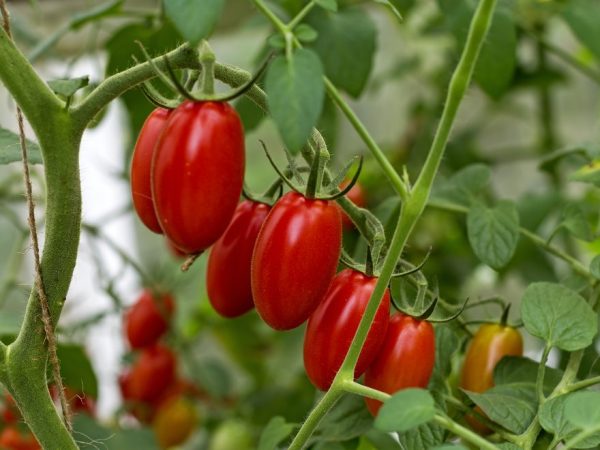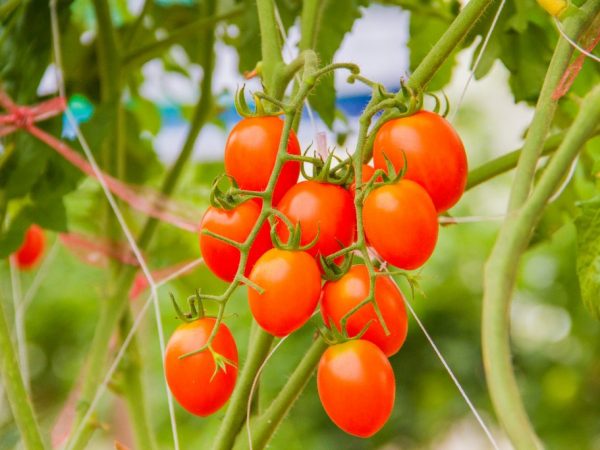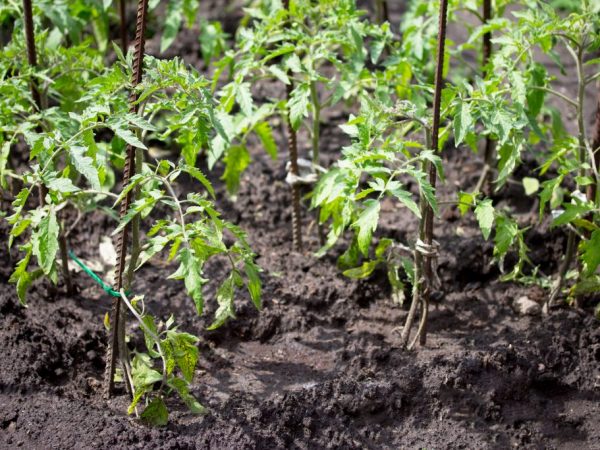Characteristics of Nastena-sweet tomatoes
Hybrids are plants specially bred to obtain a certain set of characteristics, such as weight and color of fruits, resistance to diseases. This group of plants includes the tomato Slastena and its variety f1 Nastya-sweet.

Characteristics of Nastena-sweet tomatoes
Characteristics of the variety
The variety is grown almost throughout the country: from the southern regions to the Urals and the Far East.
According to the description:
- The variety is intended for cultivation in greenhouses and open field.
- In a greenhouse, Slastena's height reaches 1.8 m.
- In terms of ripening, the variety is medium early.
- The stem bears up to 10 racemes.
- One brush contains up to 40 tomatoes.
- Fruit weight - about 100 g.
- The shape of the fruit is elongated, cylindrical.
On average, one plant produces up to 2.5 kg of fruits.
Description of the plant
The indeterminate variety Nastya-sweetheart practically does not give stepchildren, but they are removed when they appear.
The fruits hang in long garlands, so the variety is grown in 1-2 stems. If there are more stems, the fruits are often in contact with each other, which provokes gray rot.
There are very few leaves on the stems of the f1 Nastya-sweet tooth. Moreover, they are small, evenly colored. When grown outdoors, the color is dark green, in a greenhouse it is lighter. The veins are weakly expressed.
Description of fruits
The first brush of these cherry tomatoes is formed around 8 or 9 leaves. The next brushes are in 3-4 leaves. The inflorescence is simple, contains up to 40 flowers. Flowers open and pollinate alternately, so the brush looks like a long ampelous waterfall of fruits.
When ripe, the fruits are:
- pink;
- red;
- crimson;
- yellow.
Tomatoes are covered with a dense skin that is not prone to cracking, but if an excess of moisture is felt in the soil, cracking still occurs. This spoils their taste and presentation.

Tomato fruit has a sweet taste
Preparation for sowing seeds
Tomatoes in Siberia and the Far East are grown in greenhouses and only by seedlings. The seeds of the hybrids are bought at the store.
The temperature in nurseries should not be lower than 25 ° C during the day and 16 ° C at night. Land is purchased in specialized stores or created independently. Coarse sand, wood ash and rotted manure, sometimes small sawdust of fruit trees, are added to the soil to make it lighter and more crumbly. Drainage is imperative.
Sowing seeds
Before sowing, the seeds of a high-yielding tomato Slasten are disinfected in a weak solution of potassium permanganate for 8 hours. Sometimes granulated seeds treated with growth stimulants are purchased. They are sown without any preliminary treatments.
A thin layer of drainage is poured onto the bottom of pots or deep bowls, after which about 10 cm of soil is added and leveled without tamping. Washed and slightly dried seeds are laid out on the surface, but not thickly. Top with a layer of no more than 1 cm, soil is poured.
The ground is sprayed with water from a spray bottle and covered with polyethylene. The plantings are placed in a bright place and the condition of the soil is monitored. If everything is done correctly, shoots will appear in 5 or 6 days. Plants stay in nurseries for about 60 days.
Care of tomato seedlings
When two pairs of leaves appear on the shoots, the plant dives.
There are several more rules for caring for sprouts:
- Seedlings should receive a lot of light.
- It is necessary to maintain a certain temperature.
- As the topsoil dries up, it is important to water it.
It is impossible to moisturize the plantings too much: excess moisture leads to rotting of the leaves, and this is fraught with diseases.
Disembarkation to a permanent place

Plants need a garter
In the southern regions, tomatoes are planted in open ground. Before that, the seedlings are hardened for two weeks. On the first day, the plants are exposed for half an hour. At the second time, they increase again, and so on.
Plants do not need hardening for greenhouse cultivation. They are simply carefully removed from the nursery and then transported to the greenhouses.
The land should be marked out so that there are 4 bushes per 1 m². They are planted in a checkerboard pattern. A handful of ash is added to the holes, after which they are poured with warm water. Strong supports or trellises are installed near each hole.
Sufficiently tall sprouts are immediately tied up. The soil near the stems is mulched. A fine straw or a dark film is suitable for this.
Bush care
The main components of care are:
- watering;
- weeding and loosening;
- destruction of insects and slugs;
- disease prevention.
Plantings are watered once a week. Do this with warm water. After watering, loosening is carried out, which does not allow the soil to form a crust when it dries.
Lime is scattered in the passages and on the paths: this scares away slugs. For the destruction of small insects, insecticides of a wide spectrum of action are acquired.
Fertilizer
For the first time, plantings are fertilized after the plants have taken root. For this, complex mineral fertilizers applied by spraying the bushes are suitable. Foliar dressing can be carried out before the formation of the first brush. The time between feeding is 15 days.
Organic mixtures are prepared on their own.
- Take a large container.
- Half fill it with rotted mullein or bird droppings and add water.
- Keep the mixture warm for two weeks, stirring occasionally for better fermentation.
- The finished substance is diluted with warm water in a ratio of 1:10 and the plants are watered at the root.
Varieties are practically not affected by late blight, gray mold, powdery mildew and other viruses, but it is better to process them for prevention. Fitosporin, Bravo, Aktara and other chemicals are used.
Conclusion
Slastena tomatoes are a decoration of the garden. Thanks to this fertile cherry variety, you can easily stock up on fruits for the whole winter.


